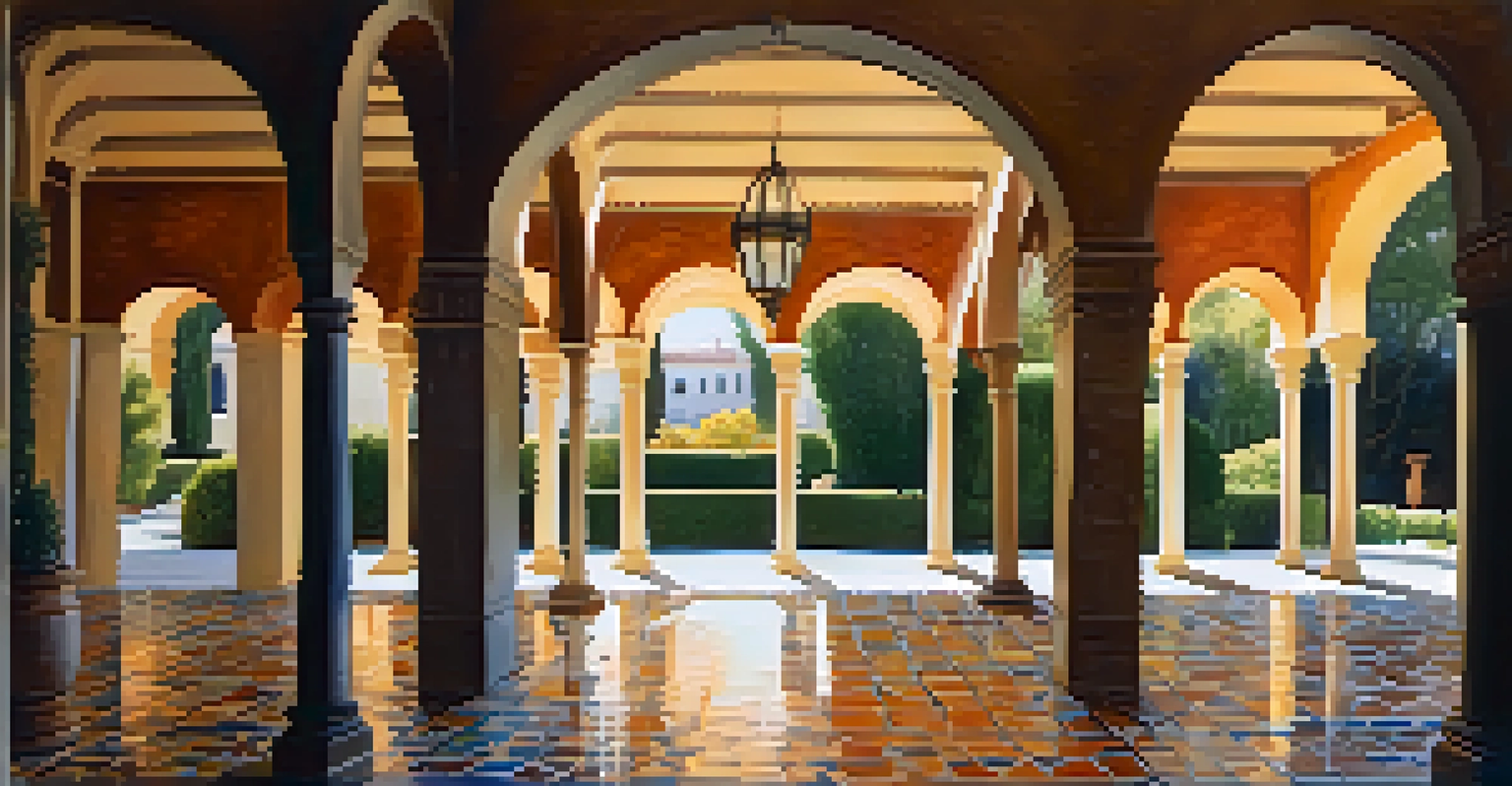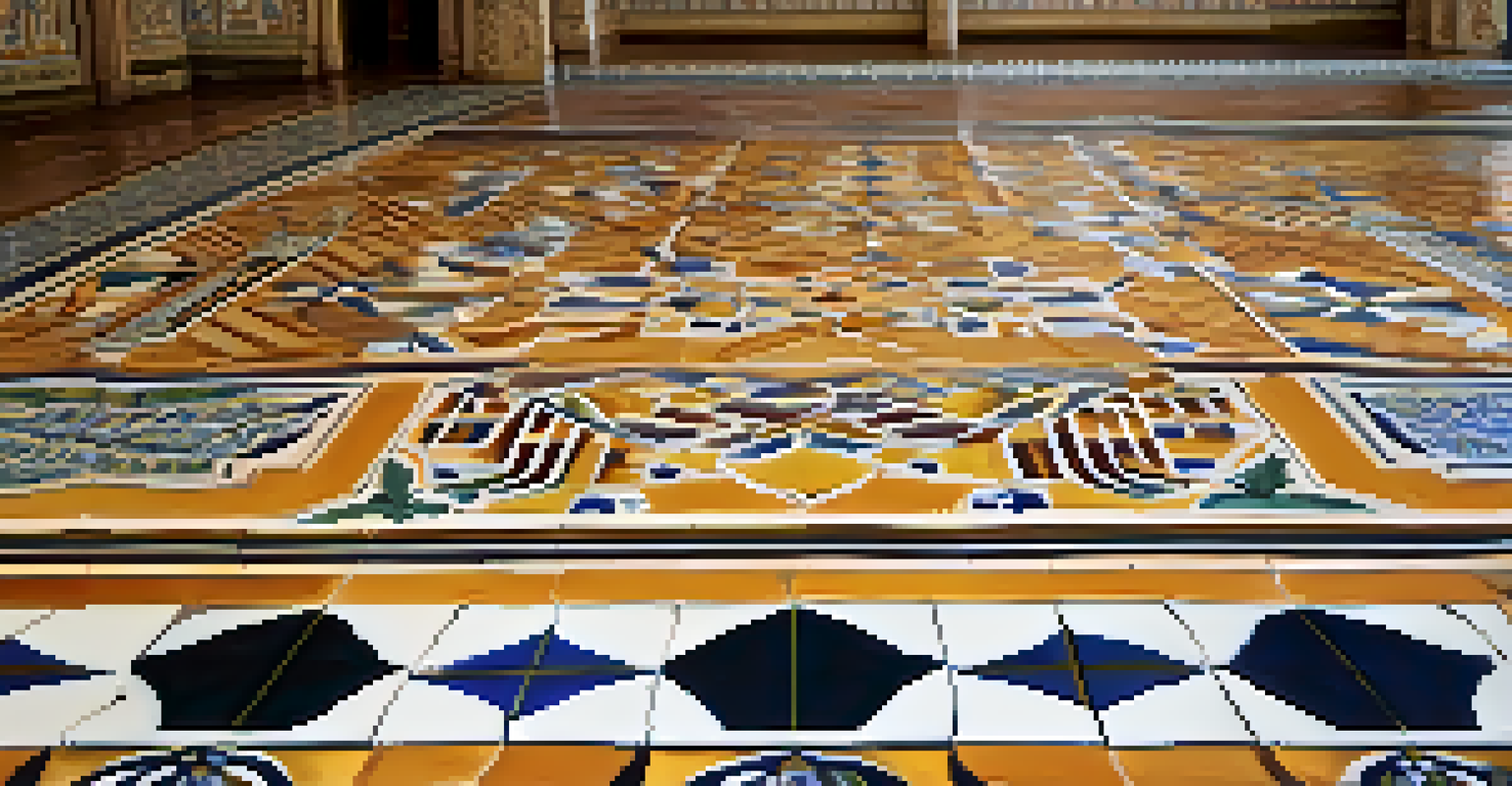The Spanish Governor's Palace: A Glimpse into Texas' Past

The Historical Significance of the Palace
The Spanish Governor's Palace, located in San Antonio, serves as a vital link to Texas' colonial past. Built in the 18th century, this structure was once the seat of government for Spanish Texas, showcasing the blend of cultures that shaped the region. It stands as a testament to the Spanish influence on Texas, making it an essential stop for history enthusiasts.
History is not a burden on the memory but an illumination of the soul.
As one of the oldest buildings in San Antonio, its architecture reflects the Spanish Colonial style, characterized by thick walls, arched doorways, and vibrant tile work. Visitors can appreciate how these architectural elements tell a story of resilience and adaptation over centuries. This palace not only housed governors but also witnessed significant events that shaped Texas's journey to statehood.
Today, the Spanish Governor's Palace is recognized as a Texas Historical Landmark, ensuring that its rich legacy is preserved for future generations. Exploring this site offers a deep dive into the complexities of Texas’ history, inviting us to understand the past through its physical remnants.
Architectural Features of the Palace
The architecture of the Spanish Governor's Palace is a striking blend of beauty and functionality. Its sturdy limestone walls were designed to withstand the elements, while the intricate ironwork and wooden doors add a touch of elegance to the structure. These features are not just decorative; they tell stories of the artisans who crafted them and the cultural influences at play.

Walking through the palace, visitors will notice the courtyard, a serene space that once served as a gathering place for important discussions and celebrations. This open-air area is framed by the building’s arches, creating a space that feels both inviting and historically rich. The courtyard’s design exemplifies the Spanish tradition of creating communal spaces within architecture.
Historical Significance of the Palace
The Spanish Governor's Palace is a vital link to Texas' colonial past, showcasing the blend of cultures that shaped the region.
Moreover, the vibrant tiles that adorn the floors and walls are a nod to the Spanish and Mexican heritage, showcasing colorful patterns that reflect the region's artistic traditions. Each detail, from the color palette to the materials used, contributes to the overall narrative of the palace, making it a captivating subject for architectural enthusiasts.
The Role of the Palace in Texas' Governance
During its operational years, the Spanish Governor's Palace was the hub of political activity in Texas. It served as the residence for the Spanish governors, who made crucial decisions that impacted the region's development. Understanding the role of this palace provides insight into how governance was conducted during a time of colonial rule.
Preservation of one's own culture does not require contempt or disrespect for other cultures.
The palace was more than just a home; it was a center for diplomacy, where relationships were forged with Native American tribes and other colonial powers. Documents and records from this era reveal how the governors navigated the complexities of managing a diverse population. This historical context helps us appreciate the challenges faced by those in power during a transformative period.
As Texas transitioned through various governance systems—from Spanish to Mexican and eventually to American—this palace remained a symbol of authority. Exploring its history allows us to connect with the broader narrative of Texas' evolution, highlighting how political structures have changed over time.
Cultural Influences Reflected at the Palace
The Spanish Governor's Palace is a melting pot of cultural influences, representing a rich tapestry woven by Spanish, Mexican, and indigenous traditions. Each layer of culture contributes to the identity of San Antonio and, by extension, Texas itself. This unique blend is evident in the palace's architectural design, decorative arts, and even in its historical narratives.
For instance, the festivals and events held at the palace often celebrate the heritage of the communities that surround it. These celebrations bring to life the stories of the people who lived and thrived in this region, showcasing the continuity of traditions over generations. The palace acts as a backdrop for these cultural expressions, making it a living part of the community.
Architectural Features Shine
The palace's Spanish Colonial architecture and vibrant tiles reflect the artistic traditions and resilience of its era.
Moreover, art exhibits and educational programs hosted at the palace encourage visitors to engage with the diverse histories that converged in this space. By participating in these activities, guests can appreciate how the past continues to influence contemporary cultural practices in Texas.
Visiting the Spanish Governor's Palace Today
Today, the Spanish Governor's Palace is open to the public, offering a glimpse into its storied past. Visitors can explore its beautifully preserved rooms and courtyards, which are filled with artifacts and exhibits that tell the story of Texas’ colonial era. This immersive experience allows guests to step back in time and imagine life during the 18th century.
Guided tours are available, providing deeper insights into the history and significance of the palace. Knowledgeable guides share fascinating anecdotes and lesser-known facts that enrich the visitor experience. This personal touch not only educates but also fosters a connection between guests and the history they are exploring.
In addition to tours, the palace often hosts cultural events and workshops that celebrate Texas heritage. These activities provide an engaging way for visitors to learn more about the traditions that have shaped the state, making a trip to the Spanish Governor's Palace a dynamic and enriching experience.
Preservation Efforts: Keeping History Alive
Preserving the Spanish Governor's Palace is crucial for maintaining its historical significance. Various organizations and local governments work tirelessly to ensure that this landmark remains intact for future generations. Their efforts include routine maintenance, restoration projects, and educational outreach programs aimed at raising awareness about the palace's importance.
Restoration efforts often involve meticulous research to ensure that any changes or repairs honor the original design and materials. This commitment to authenticity helps maintain the integrity of the building, allowing visitors to experience it as it was meant to be seen. Such dedication reflects a broader appreciation for preserving cultural heritage.
Educational Hub for All Ages
The palace offers numerous educational programs and workshops that engage visitors, enhancing their understanding of Texas history.
Moreover, community involvement plays a vital role in these preservation efforts. Local volunteers and historians often contribute their time and expertise, fostering a sense of ownership and pride in the palace. Through these collaborations, the Spanish Governor's Palace continues to be a cherished symbol of Texas history.
Educational Opportunities at the Palace
The Spanish Governor's Palace serves as an educational hub, offering numerous programs designed to engage visitors of all ages. School groups often visit to learn about Texas history in a hands-on environment, enhancing their understanding of the past. These educational initiatives aim to spark curiosity and foster a love for history among young learners.
Workshops and lectures hosted at the palace cover a range of topics related to Texas history, culture, and architecture. Local historians and experts share their knowledge, providing attendees with a deeper understanding of the complex narratives that have shaped the region. This programming not only informs but also invites discussions that keep the history alive.

Additionally, interactive exhibits allow visitors to immerse themselves in the stories of those who lived during the colonial period. By engaging with the past in a meaningful way, guests leave with a richer appreciation for the legacy of the Spanish Governor's Palace and its place in Texas history.